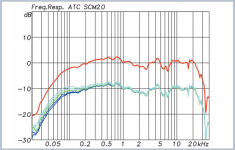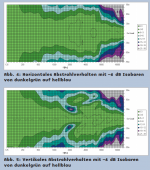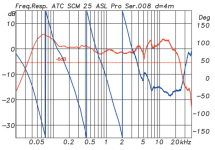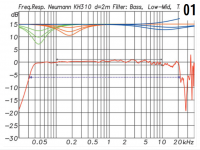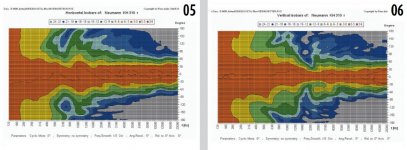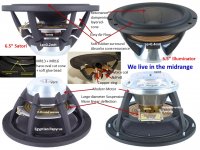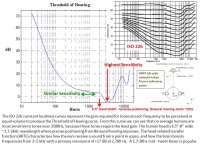PMC make their own 3" dome themselves, it is only available as a spare part.
Somebody on here has a pair of them but he wasn't telling how he got hold of them.
As spares they cost about twice as much as the ATC.
And yes ATC sells their nonb-S version to anyone who is not a direct competitor in the active Monitor market.
In that market they have refused to supply Quested, PMC and Neumann/Klein&Hummel as I mentioned many pages earlier.
Somebody on here has a pair of them but he wasn't telling how he got hold of them.
As spares they cost about twice as much as the ATC.
And yes ATC sells their nonb-S version to anyone who is not a direct competitor in the active Monitor market.
In that market they have refused to supply Quested, PMC and Neumann/Klein&Hummel as I mentioned many pages earlier.
they have refused to supply Quested, PMC and Neumann/Klein&Hummel
Do you have a reference for that? I am unaware of anything to do with Neumann/Klein&Hummel but I believe Quested and PMC both made their own decisions to source their own drivers...
I vote for that Tang Band dome which Zaph tested
On what basis? It does not appear this driver is sufficiently well engineered for the demands of the applications discussed in this thread in which primarily the ATC dome has performed with extraordinary reliability for decades.
Do you have a reference for that? I am unaware of anything to do with Neumann/Klein&Hummel but I believe Quested and PMC both made their own decisions to source their own drivers...
Neumann used the ATC dome in their former flagship O 500 C. The newer KH 420 uses their own driver (not available to public) which is superior to the old ATC design in terms of non-linear distortion. Their measurements clearly show this.
Please note that the scalings are different!
O 500 C (ATC in waveguide):
An externally hosted image should be here but it was not working when we last tested it.
KH 420 (own model):
An externally hosted image should be here but it was not working when we last tested it.
Neumann used the ATC dome in their former flagship O 500 C. The newer KH 420 uses their own driver (not available to public) which is superior to the old ATC design in terms of non-linear distortion
The low frequency suspension-dependent distortion in these plots is somewhat irrelevant given a 300-400Hz crossover.
This is also not the ATC dome used in ATC's own monitors where the rising high frequency distortion from magnetic non-linearities is significantly reduced. Using current drive as recommended previously this thread removes this distortion altogether with either dome motor system.
This is also not the ATC dome used in ATC's own monitors where the rising high frequency distortion from magnetic non-linearities is significantly reduced.
I don't know which version Neumann used. Maybe it was an older design.
There are not many measurements from ATC around. I have reliable measurements* of the SCM 20 and SCM 25 ASL. The second one uses the 3" dome. THD-limited maximum SPL in the midrange is still lower than of the Neumann KH 310. This is nothing to complain, because, it is still high.
I only complain about the frequency response which is pretty bad and very different on both ATC monitors. Additionally ATC doesn't control directivity. I find that the biggest flaw of their monitors. Even in well-treated studios there is always a power response.
Don't get me wrong. The ATC dome is a fine driver, but it is an old design. The ferrit magnet ist way too big to place it near the tweeter. And nowadays drivers can be optimized (using Klippel analyzers etc.) just a step further.
*if there is interest I can publish them
Additionally ATC doesn't control directivity. I find that the biggest flaw of their monitors. Even in well-treated studios there is always a power response.
I do agree about that too but in most recent control room design there is nearly always an rfz minimizing (or erasing) objectionnable early reflections and frequency of interest (for this kind of dome) are always and easily well controlled/mastered with acoustic treatments.
As you usually see some diffusors too in this frequency range this kind of speakers usually sound right.
Last edited:
Additionally ATC doesn't control directivity
That is simply incorrect as a wideband and monotonic power response has been one of ATC's fundamental design criteria for decades - and before it was widely talked about. Besides low colouration and a neutral (axial) balance, it is one of the reasons while all their speakers sound much the same in spite of the different sizes and drivers.
Maybe you mean a restricted polar response? If so then I refer back to my previous assertion that a speaker is no fix for poor acoustics just as good acoustics are no cure for a bad speaker. If a room has an acoustic problem then (ignoring minimum phase discrete standing waves) improving the acoustics will give the best results.
The ferrit magnet ist way too big to place it near the tweeter
Again this is an engineering compromise. A smaller magnet would deliver a lower sensitivity and a reduce heat sinking capacity by virtue of the reduced volume of metalwork.
And nowadays drivers can be optimized (using Klippel analyzers etc.) just a step further
Indeed - and I have described some in this and another related thread. But the audibility of such improvements is debatable. Moreover the thrust of my contribution in this thread was to emphasise the engineering aspects beyond that of conventional specifications: Most of the clever engineering in the ATC dome is that embedded in its manufacturing methods - and they have repeatedly delivered a driver with not only outstanding performance but I suspect unmatched reliability in high power applications for many decades.
Last edited:
That is simply incorrect as a wideband and monotonic power response has been one of ATC's fundamental design criteria for decades - and before it was widely talked about. Besides low colouration and a neutral (axial) balance, it is one of the reasons while all their speakers sound much the same in spite of the different sizes and drivers.
I can not judge all speakers from ATC, because I have only measurements of two smaller models. It seems that they tried to compensate the bad power response with an inverse direct sound. This only works if direct sound and diffuse sound have the correct proportion. In nearfield this will fail completely, because direct sound dominates. Both speakers vary by about +/- 2.5 dB in very broad frequency ranges.
Compared to the (much cheaper) equivalents from Neumann and Genelec these are not very good designs.
Please take alook at these plots:
SCM 20:
SCM 25 ASL:
And for comparison the Neumann KH310. It has a better power response, a linear amplitude response and it costs only one third (!) of the SCM 25.
Neumann KH310:
If so then I refer back to my previous assertion that a speaker is no fix for poor acoustics just as good acoustics are no cure for a bad speaker.
Of course. But I don't see a smooth power response as a fix. It is a must-have.
Attachments
I can not judge all speakers from ATC, because I have only measurements of two smaller models
The SCM20 is a two-way speaker and therefore subject to different compromises. It is not therefore the right place to add it for comparison.
It seems that they tried to compensate the bad power response with an inverse direct sound
No. As far as I am aware there is no equalisation applied
And for comparison the Neumann KH310. It has a better power response, a linear amplitude response
Yes it does. Quite extraordinarily so! Whether it is a match for the ATC in other aspects of its performance remains to be seen...
The SCM20 is a two-way speaker and therefore subject to different compromises. It is not therefore the right place to add it for comparison.
I just added it to show the differences in amplitude and power response. If you compare it to the 2-way models from Neumann and Genelec the conclusion is the same.
No. As far as I am aware there is no equalisation applied
There may be no special equalization applied. There are other ways to "shape" the amplitude response. Maybe I'm wrong with my assumption, but I see a slight correlation between widening in directivity and drop in amplitude response on both speakers.
Yes it does. Quite extraordinarily so! Whether it is a match for the ATC in other aspects of its performance remains to be seen...
Of course I can only tell from the measurements. Decay and maximum SPL is good on both speakers. I don't know what about reliability of operation etc.
Last edited:
but I see a slight correlation between widening in directivity and drop in amplitude response on both speakers.
A break-up mode will do that adding up to a dip on axis whilst appearing as a reduced radiating area otherwise so widening the directivity.
Hi Rhythmsandy!
I found your message from jan 2014 about an interesting project to make a 3" soft dome better than ATC.
What happened? Did it turn out well?
Im interested to hear what happened!
I had a recording studio i Sweden for many years, using ATC SCM150. Now I dont work in studio anymore, and have sold the ATC´s. But Im still longing for that midrange.
I have still not found a midrange that competes to ATC (and have a reasonable price), but I want to find it!
I found your message from jan 2014 about an interesting project to make a 3" soft dome better than ATC.
What happened? Did it turn out well?
Im interested to hear what happened!
I had a recording studio i Sweden for many years, using ATC SCM150. Now I dont work in studio anymore, and have sold the ATC´s. But Im still longing for that midrange.
I have still not found a midrange that competes to ATC (and have a reasonable price), but I want to find it!
I have still not found a midrange that competes to ATC (and have a reasonable price), but I want to find it!
SEARCH:
Volt VM752
---lower efficiency (88-91db SPL)
Scan Speak 12mu-4731t00
SB_Acoustics Satori MR13P-4
SB_Acoustics Satori MR16P-4
SB_Acoustics SB15NAC30-4
SB_Acoustics SB17NAC35-4
The ~$500 Volt VM752 3" textile dome midrange is used in a couple diyAudio monitors.
The Scan Speak 12mu-4731t00 has exceptional measurements, 90db SPL
The SB_Acoustics Satori MR13P-4 and MR16P-4 are medium priced
The SB_Acoustics SB15NAC30-4 and SB_Acoustics SB17NAC35-4 are modest priced aluminum cone mids.
SB_Acoustics sells modest cost 5" SB15NAC30-4 and 6.2" SB17NAC35-4 midranges with a ribbed aluminum cone for crisp details with reduced cone breakup. A search will bring up several designs.
Last edited:
Thank you very much for the information!!
I worked in recording studio before (for 25years), but now only have sound for a hobby.
Today I don't care about how to get a good sound, and I even use not "accepted" solutions to get out the best. Nothing is linear anyway, so I normally uses a 2x30equalizer to all speaker systems, and manage to get quite good results out of really bad speakers! No measurements, just listening! (If I follow measurements, it always sound worse!)
It is like tuning a grand piano. You have to take judgements about every string, tuning by ear, otherwise it will sound false and distorted, even if every string mechanically is in tune....
It also depends in at which level you want to listen. The human ear and the psykoacoustical effects also affects how you judge a sound.
But anyway, you still need good equipment to start with. For me is the midrange the most important part, where the human ear is most sensitive for faults.
I worked in recording studio before (for 25years), but now only have sound for a hobby.
Today I don't care about how to get a good sound, and I even use not "accepted" solutions to get out the best. Nothing is linear anyway, so I normally uses a 2x30equalizer to all speaker systems, and manage to get quite good results out of really bad speakers! No measurements, just listening! (If I follow measurements, it always sound worse!)
It is like tuning a grand piano. You have to take judgements about every string, tuning by ear, otherwise it will sound false and distorted, even if every string mechanically is in tune....
It also depends in at which level you want to listen. The human ear and the psykoacoustical effects also affects how you judge a sound.
But anyway, you still need good equipment to start with. For me is the midrange the most important part, where the human ear is most sensitive for faults.
For me is the midrange the most important part, where the human ear is most sensitive for faults.
For consistent TONE, a speaker designer using DSP with 1-amplifier per driver can put the human vocal range (80-1100Hz) (E2 to C6) on one well designed midrange driver... like the Satori MR16P-4, which trades some dynamics (~91db SPL) for a smoother frequency response. The MR16P-4 has an elliptical cut cone and a ring of soft silicone around the back of the cone.
Copy of earlier post====
The ISO 226 constant loudness curves represent the gain required for tones at each frequency to be perceived at equal volume to produce the Threshold of Hearing curve. From this curve we can see that on average humans are most sensitive to tones near 3500Hz, because these tones require the least gain. The human head is 6.5”-9” wide ~1.5-2kHz wavelength where sound positioning from Binaural hearing improves. The head-related transfer function (HRTF) characterizes how an ear receive a sound from a point in space, and how the brain boosts frequencies from 2–5 kHz with a primary resonance of +17 dB at 2,700 Hz. A 1.6-2Khz mid - tweet Xover is popular.
Attachments
What do you guys think about Purifi Audio PTT4.0X04? 84dB, though...
Purifi Audio PTT4.0X04-NFC-01 4.5" Mid-Woofer-4 ohm
Purifi Audio PTT4.0X04-NFC-01 4.5" Mid-Woofer-4 ohm
Last edited:
It's a low-efficiency and compact mid-woofer. The choice has been made to sacrifice a huge amount of efficiency for LF bandwidth. The Purifi is clearly meant to serve as the bottom of a compact loudspeaker driven by a Class D amplifier and an SMPS. The driver would burn at playback levels the ATC/Volt mid could easily handle. This disqualifies it as a midrange driver for large format speakers.
There are some drivers that are comparable in linearity, some that compare in sensitivity/efficiency, but most of these have a much larger radiating area than a 3-inch dome mid would. Given the modern surge of dome tweeters that are comfortable being crossed at 2kHz or below, you might be inclined to treat radiating area a bit more flexibly.
There are some drivers that are comparable in linearity, some that compare in sensitivity/efficiency, but most of these have a much larger radiating area than a 3-inch dome mid would. Given the modern surge of dome tweeters that are comfortable being crossed at 2kHz or below, you might be inclined to treat radiating area a bit more flexibly.
- Home
- Loudspeakers
- Multi-Way
- Better dome midrange design than ATC?
